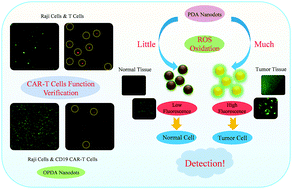Two-photon fluorescent polydopamine nanodots for CAR-T cell function verification and tumor cell/tissue detection†
Abstract
Chimeric antigen receptor T-Cell (CAR-T) immunotherapy has been regarded as one of the most promising methods for cancer therapy. How to verify CAR-T cell function and efficiency is very significant for clinical applications. Meanwhile, the identification of tumor cells/tissues is very important for tumor diagnosis and operation. In this study, biocompatible and mass-produced polydopamine (PDA) nanodots have been prepared by a facile method. Oxidized polydopamine (OPDA) can be synthesized by the reaction between PDA and hydrogen peroxide at atmospheric pressure and temperature, and it possesses both one-photon and two-photon fluorescence properties. OPDA nanodots can image living cells for long time periods without mitosis and proliferation inhibition. After ingestion of OPDA nanodots, Raji cells can be used to verify CAR-T cell lethality and efficiency by visualization through fluorescence. The fluorescence intensity change originating from the conversion of PDA into OPDA can function as a signal to identify the tumor and normal cells/tissues because of the different concentration of ROS in tumor cells (high) and normal cells (low). Therefore, the facile synthesis of mass-produced novel organic nanodots with two-photon fluorescence properties will have wide applications in long time living cell imaging without mitosis and proliferation inhibition, CAR-T cell function verification and tumor cell/tissue detection.



 Please wait while we load your content...
Please wait while we load your content...